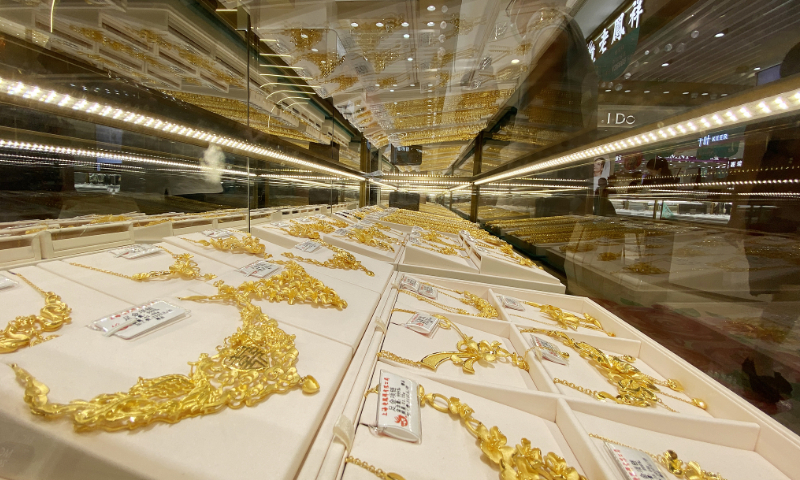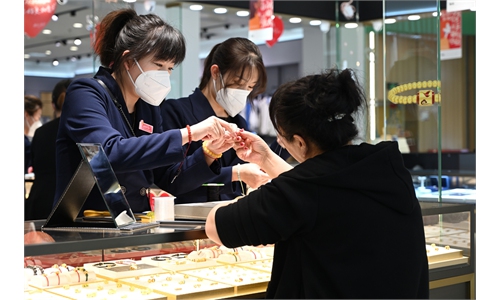
Photo: VCG
"It's like a wet market crowded with stalls, except that people are trading gold jewelry, not meat and vegetables," 30-year-old Shenzhen resident Guo said when describing Shuibei, a local jewelry wholesale market.
Founded in 2004 and known mostly to jewelry traders, the market has become popular among individual consumers thanks to short video platforms like Douyin, as well as a nationwide gold craze.
China's domestic consumption of gold jewelry reached 198 tons in the first quarter of 2023, the strongest quarterly demand in eight years, according to the World Gold Council. It constitutes an 11 percent increase year-on-year and is 56 percent more than in the fourth quarter of 2022.
Zhao Jing, who lives in Nanjing, East China's Jiangsu Province, is planning a trip to Shuibei to buy wedding gold.
A wedding tradition in China is to buy "three gold" - necklace, earrings and ring - or "five gold" - the three plus bracelet and bangle - for brides. As many young couples postponed their weddings until 2023 due to the COVID-19 pandemic, purchasing of gold is unsurprisingly rising.
Zhao chose Shuibei rather than more convenient local stores and well-known brands mainly because of the price.
The price of gold jewelry is set by its weight and the international gold price, which would be the same at all sellers, but there is also a processing fee that varies at different stores. This charge at Shuibei market is much lower than at famous brands, making it an attractive place for younger consumers who are more sensitive to prices, the Global Times learned.
According to a 2022 observation report on China's gold jewelry industry, the proportion of members of generation Z who want to buy gold jewelry increased from 16 percent in 2016 to 59 percent in 2021.
The consumption data shows the intention has been transformed into action.
According to a report released by the LeadLeo Research Institute in mid-March, 55 percent of consumers frequenting gold shops are aged 25 to 34. Consumers aged 35 to 44 make up the second-largest group, accounting for 36 percent of gold store shoppers.
For people who cannot come to Shuibei in person, buying online is an easy option. The market has its own livestreaming channels, some wholesalers have online stores, and buying agents are more than willing to serve a customer.
Embracing online channels is a must for gold sellers to reach young customers, who may not walk into a jewelry store but spend a lot of time on short video platforms and shopping apps.
But why are the young generation more interested in gold than before?
"It's about consumption, but also savings," a Beijing white collar worker surnamed Sun told the Global Times. Sun bought a gold bracelet and a pendant during the 6.18 online shopping festival.
Having worked for several years, Sun used to buy a handbag to celebrate bonus day, birthdays and promotions. But since the pandemic, Sun no longer has that many occasions "in need of a fancy bag" and she "suddenly realized so many bags were going unused and had cost a lot of money."
Many young people like Sun - who have stable disposable income but want to consume in a more rational way in the face of economic uncertainty - are turning to gold.
"If I do not buy gold, the money will be spent on brands like Swarovski or Pandora, or clothes and cosmetics," a college graduate told the Global Times on lifestyle sharing platform Xiaohongshu.
"Of course, to sell gold jewelry won't be as convenient as gold bars and there will be depreciation, but I want to wear them rather than store them in a safe and keep worrying about a thief," Sun said in a joking tone. "Hopefully I won't face financial problems that will force me to sell them in the future."
Another reason more young people want to buy gold jewelry is because of the increasingly innovative designs. Designs based on those seen in hit TV dramas or animations, as well as "China chic" designs inspired by traditional culture are among the most popular.
Gold jewelry used to be associated with "rich aunties" in China, but now the young want to shop accessories that can "keep the value" and diverse, innovative designs have met their fashion tastes.



